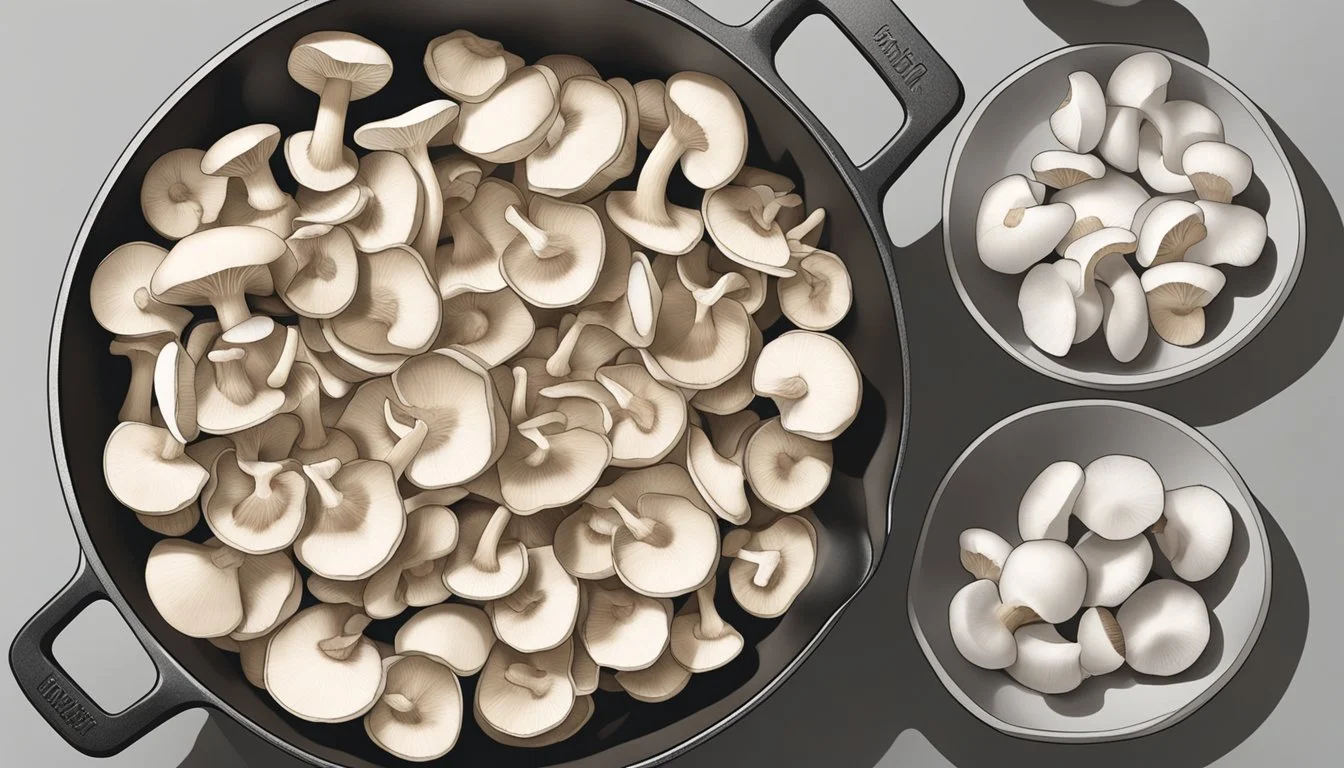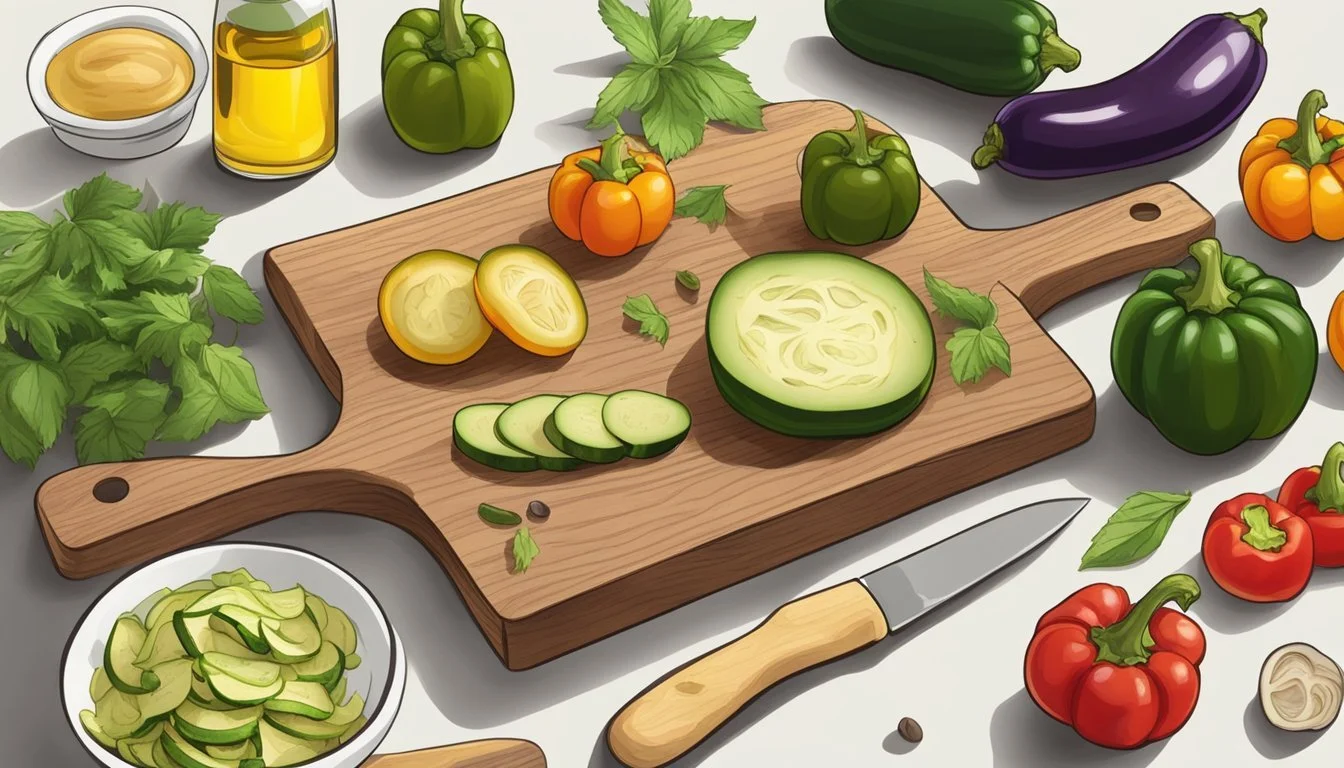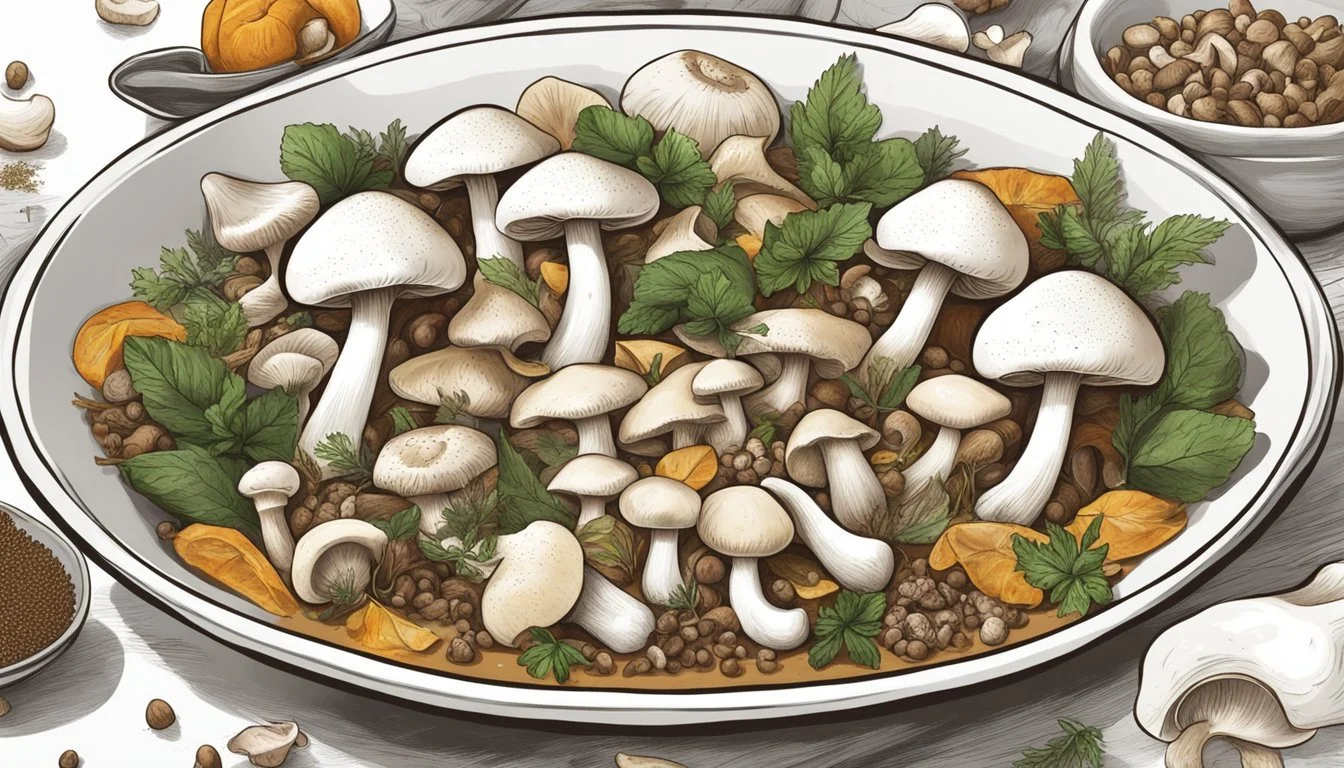How to Substitute White Mushrooms for Cremini Mushrooms
Simple Swap Guide
Cremini mushrooms (What wine goes well with mushrooms?), also known as baby bellas, are a popular choice for many cooks due to their rich flavor and firm texture. However, there are instances where they may not be readily available or a recipe calls for a lighter taste. This is where white mushrooms come into play as a suitable substitute. They belong to the same fungal family as cremini mushrooms, which makes them a convenient alternative.
White mushrooms, often referred to as button mushrooms, offer a milder flavor and are younger than their cremini counterparts. While the taste profile is less intense, their similar texture and moisture content allow for a seamless transition in most dishes. Those looking to replace cremini mushrooms will find that white mushrooms can be used in equal measure, making the swap direct and fuss-free.
When opting for white mushrooms as a substitute for cremini mushrooms, the nuances of the dish may shift slightly, but the result will still be delicious and satisfying. It's important for home cooks and chefs alike to understand the versatility of mushrooms and the ease with which they can adapt recipes to suit their available ingredients. Whether in a sauté, stir-fry, or soup, white mushrooms can confidently take the place of cremini mushrooms without compromising the integrity of the dish.
Understanding Cremini Mushrooms
Cremini mushrooms are appreciated for their rich flavor and versatility in cooking. They offer a savory taste that is both earthy and umami, making them a popular choice in a variety of recipes.
Characteristics of Cremini Mushrooms
Cremini mushrooms, also known as baby bellas, are the intermediate stage of the Agaricus bisporus species, which includes white button mushrooms and portobellos. They are distinguished by their firm texture and light to rich brown color. The flavor of cremini mushrooms is deeper and more robust than that of their younger counterpart, the white mushroom, owing to their marginally longer growth period. They provide a savory, earthy flavor with a hint of umami, which is a satisfying and meaty taste sensation that deepens the flavor profile of dishes. In terms of nutritional value, cremini mushrooms are a good source of protein and essential nutrients, reinforcing their role as a substantial ingredient in various recipes.
Common Uses in Recipes
In the culinary world, cremini mushrooms are valued for their versatility. They can easily replace white mushrooms in recipes due to their similar textures, yet they offer a more pronounced flavor that complements a wide range of dishes. Cremini mushrooms are commonly used in the following preparations:
Sautéed as a side dish or incorporated into pastas, risottos, and omelets
Roasted to concentrate their flavor and serve as a hearty addition to salads and meats
Stewed within soups and casseroles for added depth and meatiness
Their natural umami quality enhances savory dishes and they are often included in:
Stir-fries for an extra boost of flavor without overwhelming other ingredients
Stuffed mushroom appetizers, where their firm texture holds up well against baking and stuffing with various fillings
White Mushrooms and Their Properties
White mushrooms, belonging to the species Agaricus bisporus, are popular in culinary use due to their mild flavor and versatile texture. These commonly found mushrooms offer a neutral taste that can complement a wide range of dishes.
Flavor Profile of White Mushrooms
White mushrooms have a relatively neutral flavor profile, which makes them a blank canvas for a variety of dishes. Their taste is subtle, neither overpowering nor distinctive, allowing them to easily absorb the flavors of other ingredients they are cooked with. This makes them particularly suitable for recipes where they are not the feature ingredient but instead contribute to a broader array of flavors.
Texture and Culinary Applications
The texture of white mushrooms is somewhat spongy, allowing them to retain water and stay moist during the cooking process. In terms of culinary applications, they boast a high degree of versatility:
Raw: White mushrooms can be sliced and used fresh in salads, providing a pleasant, crisp texture.
Cooked: When cooked, they become tender and can be used in a wide variety of cooking methods, including:
Sautéing
Grilling
Baking
Stewing
Due to their spongy nature, they can also soak up marinades and sauces, which enhances their flavor in the finished dish.
Substitution Basics
When substituting white mushrooms for cremini mushrooms, the key elements to consider are aligning the type of mushrooms with their respective culinary roles and understanding how flavor and texture differences may influence the outcome of a dish.
Substituting Mushrooms by Type
White mushrooms can be used as a direct substitute for cremini mushrooms in most recipes as they are botanically similar. They are both strains of Agaricus bisporus; white mushrooms are harvested younger, while cremini are slightly more mature. When substituting:
Equivalent: Use a one-to-one ratio when replacing cremini mushrooms with white mushrooms.
Preparation: Ensure that the preparation methods (slicing, dicing, sautéing) are kept consistent for equivalent results.
Considerations for Flavor and Texture
Although these mushrooms can be similar in shape and size, careful consideration must be given to their flavor and texture differences:
Flavor: Cremini mushrooms have a slightly deeper and earthier flavor compared to the milder taste of white mushrooms. Anyone seeking an exact flavor match should bear this in mind and adjust seasoning accordingly.
Texture: In terms of texture, cremini has a firmer and denser texture, which may be noticeable in stir-fries, soups, and stews. As white mushrooms are softer, they may cook faster and release more water, thereby potentially altering the texture of a dish.
How to Substitute White Mushrooms for Cremini
When replacing cremini mushrooms with white mushrooms, cooks should focus on adjusting cooking techniques and enhancing the flavor to match the savory profile of cremini.
Adjustments in Cooking Techniques
White mushrooms tend to release more water when cooked and have a less meaty texture compared to cremini. To tackle this difference:
Sauté: Cook them over medium-high heat in a wide pan to allow excess moisture to escape and promote browning. Sautéing white mushrooms until the released water evaporates can mimic the firmer texture of cremini.
Roasting: Spread them in a single layer on a baking sheet to ensure even cooking. Roasting at a higher temperature (around 400°F) can help dehydrate the mushrooms and concentrate their flavor, making them a closer match to cremini in recipes.
Matching Cremini Flavor in Recipes
To match the rich and deeper flavor profile of cremini mushrooms, consider the following seasoning adjustments:
Herbs: Incorporate herbs like thyme and parsley to infuse savory notes into the white mushrooms.
Wine Deglaze: Use a splash of white wine after sautéing to add complexity and reduce the wine to concentrate its flavor.
Seasonings: A modest amount of soy sauce or Worcestershire sauce can be added for umami depth, closely simulating the more robust taste of cremini mushrooms.
Recipe-Specific Substitution Tips
When substituting white mushrooms for cremini mushrooms, chefs should take into account the dish's flavor profile and cooking method. The textural qualities and moisture content of white mushrooms closely resemble those of cremini mushrooms, making them an excellent substitute in various recipes.
For Soups and Sauces
In soup and sauce recipes, white mushrooms can seamlessly replace cremini mushrooms as they contribute a similar consistency and absorb flavors well. One should finely chop or slice the white mushrooms to mimic the size and texture of creminis. For a mushroom soup, where cremini's slightly earthier taste is key, a combination of white mushrooms with a hint of a more robust variety, like shiitake, can help achieve a closer flavor match.
For Roasts and Baked Dishes
In roasts and baked dishes, where mushrooms are often used for their meaty texture, white mushrooms are an excellent stand-in for cremini. They should be sliced or quartered and can be roasted or baked alongside vegetables or meats. It's important to note that white mushrooms may release more liquid than creminis when cooked, so chefs might need to adjust cooking times accordingly to avoid overly moist dishes.
For Vegan and Vegetarian Recipes
In vegan and vegetarian recipes, mushrooms often replace meat, so flavor and texture are paramount. White mushrooms work well in lieu of cremini mushrooms, especially in dishes like stir-fries and grilled plates. One may need to cook them slightly longer to achieve the desired firmness. To enhance their umami flavor, which is especially important in vegan dishes, one might consider marinating the mushrooms before cooking or adding a splash of soy sauce or balsamic vinegar during the cooking process.
Other Mushroom Varieties as Substitutes
When substituting white mushrooms for cremini, it's crucial to consider the texture and flavor compatibility of alternative mushroom varieties. This next section explores suitable mushroom substitutes, focusing on their distinctive properties.
Portobello and Baby Bella Mushrooms
Portobello mushrooms are fully-grown versions of cremini mushrooms, which means they share a similar flavor profile but with a more pronounced umami quality. Their large, robust caps are particularly suitable for grilling and stuffing. Baby Bella mushrooms, also known as Cremini mushrooms, can replace white mushrooms directly, offering a deeper, earthier flavor and meatier texture.
Shiitake and Maitake Mushrooms
Shiitake mushrooms boast a rich, buttery taste when cooked, which can enhance dishes that call for white mushrooms. They are revered for their umami flavor and tender yet chewy texture, which stands out in stir-fries and soups. On the other hand, Maitake mushrooms, recognized for their frilly edges and hearty structure, add a woodsy taste to meals and are excellent in sautés and risottos.
Oyster and King Oyster Mushrooms
Oyster mushrooms present a delicate texture and a slightly sweet, anise-like flavor that works well in lightly seasoned dishes. They're often used in their entirety, including the luscious caps and tender stems. King Oyster mushrooms are larger and have a meaty texture, making them a fantastic choice for hearty recipes. They carve out a niche in vegan and vegetarian cooking as a stand-in for scallops (What wine goes well with scallops?) or poultry due to their substantial size and savory taste profile.
Non-Mushroom Alternatives
When cremini mushrooms are not available, or a diner prefers not to include mushrooms in their dish, several non-mushroom alternatives can be used effectively. These substitutes not only mimic the texture and bulk that mushrooms provide but can also enhance the flavor of the dish.
Vegetable Substitutes
Vegetables can play a crucial role in replicating the density and umami flavor commonly associated with cremini mushrooms. Here are some options:
Eggplant (What wine goes well with eggplant?): With its spongy texture, eggplant is excellent for absorbing flavors and adds a meaty texture to dishes.
Cauliflower: Florets can provide a substantial bite and are versatile in various cooking methods, such as roasting or sautéing.
Zucchini: Mild-flavored and with a tender texture when cooked, zucchini can replace cremini mushrooms in most recipes volume for volume.
Protein-Based Substitutes
For those seeking to add a protein boost in the absence of mushrooms, these alternatives are ideal:
Tofu: Firm or extra-firm tofu, diced into small pieces and seasoned well, can be a pertinent meat substitute that emulates the bite of mushrooms.
Tempeh (What wine goes well with tempeh?): Another soy-based option, tempeh has a nutty flavor and can satisfactorily replace mushrooms when crumbled or chopped.
By integrating these non-mushroom substitutes, one can maintain the dish's heartiness and robust flavor without reliance on the cremini mushroom itself.
Enhancing Dishes with Spices and Herbs
When substituting white mushrooms for cremini mushrooms, it's crucial to complement their subtle flavor profile with the right spices and herbs. This enhances the savory and umami qualities of the mushrooms in any dish.
Choosing the Right Seasonings
Selecting seasonings that enhance the natural flavors of white mushrooms starts with understanding their mild taste. Mushrooms are versatile and can carry a range of flavors, from simple to complex. Here is a list of some of the best spice choices:
Garlic Powder: Adds depth to mushroom dishes (What Wine Pairs Perfectly with Mushroom Dishes).
Paprika: Provides a warm, slightly smoky flavor and can lend a subtle heat.
Cumin: Introduces smoky notes, perfect for earthy mushroom dishes.
Black Pepper: A classic seasoning that brings out the natural taste of mushrooms.
Herbs That Complement Mushrooms
Herbs are just as important as spices when it comes to building flavor. They should enhance, not overpower, the delicate taste of white mushrooms. Here are some herbs that pair well with them:
Thyme: Its earthy and slightly floral notes embrace the mushrooms' natural flavors.
Parsley: Offers a fresh, lightly peppery taste that brightens the dish.
Rosemary: A pungent herb that should be used sparingly to complement the mushrooms without dominating.
By using these spices and herbs thoughtfully, cooks can bring out the savory and umami properties of white mushrooms, mimicking the richer flavor of cremini mushrooms effectively.
Final Considerations for a Successful Substitute
When substituting white mushrooms for cremini mushrooms in savory dishes, it is crucial to consider how the mushrooms' differing qualities affect taste and texture. An awareness of cooking times is also important to maintain the integrity of the dish.
Taste Adjustment and Cooking Times
White mushrooms are milder compared to the slightly earthy and more robust flavor of cremini mushrooms. This means that when one replaces cremini with white mushrooms, they may need to adjust seasonings to better mimic the intended taste of the dish. Seasonings such as:
Soy sauce or worcestershire sauce can compensate for the umami depth.
Fresh herbs can be introduced to add flavor complexity.
White mushrooms also tend to absorb flavors readily, which chefs can use to their advantage by cooking them in well-spiced liquids. However, they usually require shorter cooking times than cremini. Paying careful attention to the doneness of white mushrooms is important to prevent them from becoming too soft or losing structure.
Maintaining the Integrity of the Dish
The texture of the mushroom is paramount in dishes where mushrooms play a key role. White mushrooms, although similar, are less dense and can become soggy if overcooked. To maintain a texture akin to cremini mushrooms, chefs should:
Sauté white mushrooms over medium-high heat until golden.
Add them towards the end of the cooking process if the recipe involves simmering or braising.
In summary, by consciously adjusting taste and cooking methods, white mushrooms can act as a successful substitute for cremini mushrooms in savory dishes, ensuring the dish retains its desired flavor profile and textural integrity.









